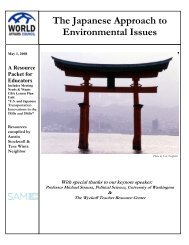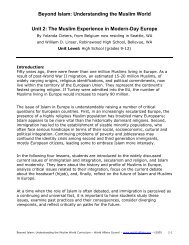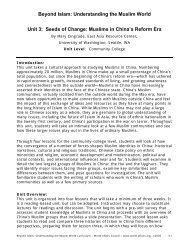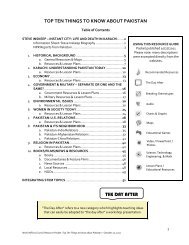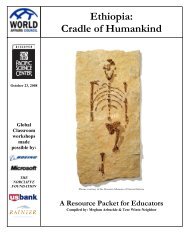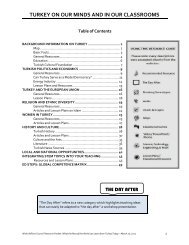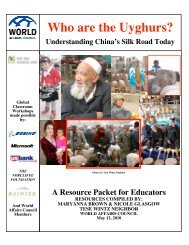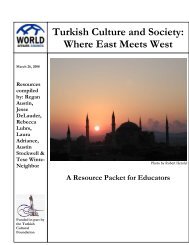If King Tut Could Talk - World Affairs Council
If King Tut Could Talk - World Affairs Council
If King Tut Could Talk - World Affairs Council
- No tags were found...
Create successful ePaper yourself
Turn your PDF publications into a flip-book with our unique Google optimized e-Paper software.
Imperialism and the Repatriation of ArtifactsSUITABLE FOR GRADES 6-12U.S. Department of State: Who’s Right? Repatriation of Cultural Property (11/02/2010)http://iipdigital.usembassy.gov/st/english/publication/2010/10/20101022140412aidan0.7519953.html#axzz25dsJO3JmTwo experts debate whether art and artifacts should be repatriated. FOR: Governments typically arguefor the repatriation of artifacts and works of art to protect their culture and prevent exploitation byforeign museums and collectors. Malcolm Bell explains the legal and moral justification of these claims.AGAINST: Providing museum visitors with a diverse range of art from around the world promotesinquiry, tolerance and broad knowledge. Artistic creations transcend national boundaries as well as thecultures and peoples that created them, argues James Cuno.Repatriation and the British Museumhttp://digitalhistory.concordia.ca/gtaylor/bm/index.htmlThis webpage addresses repatriation, which is the returning of art and artifacts to their countries oforigin... Our goal is to provide you the user with comprehensive analysis of various repatriation cases,allowing you to draw your own inferences and come to your own conclusions.An Examination of Archaeological Ethics and the Repatriation Movement, Respecting CulturalProperty (Part Two) (Fall 2004)http://environs.law.ucdavis.edu/issues/28/1/cohan.pdfThis article looks at the looting of archaeological sites and the sale of looted artifacts on the blackmarket. The article examines how looting destroys cultural sites and the heritage of cultural groupsand considers the related problem of lack of provenance of looted artifacts. (116 pages)The NY Times: Repatriating <strong>Tut</strong> (Editorial) (11/28/2012)http://www.nytimes.com/2010/11/29/opinion/29mon4.html?ref=tutankhamen&moc.semityn.wwwWhen <strong>King</strong> <strong>Tut</strong>ankhamen’s tomb was discovered in 1922, the world instantly craved a first-hand sightingof the golden sarcophagus, exquisite funerary jewels and divine chariots accompanying the Boy <strong>King</strong>through the Big Sleep. Nearly 90 years later the enthusiasm — and the entrepreneurial desire to exploit it— continues.National Endowment of the Humanities: Repatriation of Cultural Objects Webquest (2008)http://www.lakelandschools.us/lh/bgriffin/Library/meso_buttons/lssn_plan.pdfUsing a Webquest, students will learn about the issue, complete a worksheet, and write a positionstatement on where they determine the Maya Codex belongs.BOOK: James Cuno: Who Owns Antiquity? (04/21/2008)http://www.amazon.com/Who-Owns-Antiquity-Museums-Heritage/dp/0691137129Whether antiquities should be returned to the countries where they were found is one ofthe most urgent and controversial issues in the art world today. Cuno argues thatnationalistic retention and reclamation policies impede common access to this commonheritage and encourage a dubious and dangerous politicization of antiquities—and ofculture itself. Cuno calls for measures to broaden rather than restrict international accessto antiquities. (Image right). Idea: Photocopy the introduction (available to preview online)for students to read and discuss.<strong>World</strong> <strong>Affairs</strong> <strong>Council</strong> Resource Packet: Pacific Science Center Presents—The Golden <strong>King</strong> and the Great Pharaoh: November 1, 201221



